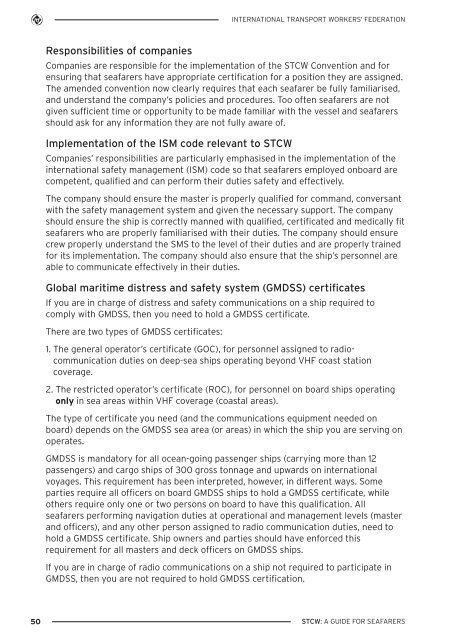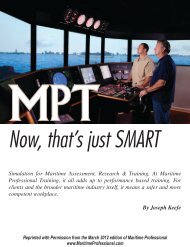STCW A GUIDE FOR SEAFARERS - Maritime Professional Training
STCW A GUIDE FOR SEAFARERS - Maritime Professional Training
STCW A GUIDE FOR SEAFARERS - Maritime Professional Training
Create successful ePaper yourself
Turn your PDF publications into a flip-book with our unique Google optimized e-Paper software.
INTERNATIONAL TRANSPORT WORKERS’ FEDERATIONResponsibilities of companiesCompanies are responsible for the implementation of the <strong>STCW</strong> Convention and forensuring that seafarers have appropriate certification for a position they are assigned.The amended convention now clearly requires that each seafarer be fully familiarised,and understand the company’s policies and procedures. Too often seafarers are notgiven sufficient time or opportunity to be made familiar with the vessel and seafarersshould ask for any information they are not fully aware of.Implementation of the ISM code relevant to <strong>STCW</strong>Companies’ responsibilities are particularly emphasised in the implementation of theinternational safety management (ISM) code so that seafarers employed onboard arecompetent, qualified and can perform their duties safety and effectively.The company should ensure the master is properly qualified for command, conversantwith the safety management system and given the necessary support. The companyshould ensure the ship is correctly manned with qualified, certificated and medically fitseafarers who are properly familiarised with their duties. The company should ensurecrew properly understand the SMS to the level of their duties and are properly trainedfor its implementation. The company should also ensure that the ship’s personnel areable to communicate effectively in their duties.Global maritime distress and safety system (GMDSS) certificatesIf you are in charge of distress and safety communications on a ship required tocomply with GMDSS, then you need to hold a GMDSS certificate.There are two types of GMDSS certificates:1. The general operator’s certificate (GOC), for personnel assigned to radiocommunicationduties on deep-sea ships operating beyond VHF coast stationcoverage.2. The restricted operator’s certificate (ROC), for personnel on board ships operatingonly in sea areas within VHF coverage (coastal areas).The type of certificate you need (and the communications equipment needed onboard) depends on the GMDSS sea area (or areas) in which the ship you are serving onoperates.GMDSS is mandatory for all ocean-going passenger ships (carrying more than 12passengers) and cargo ships of 300 gross tonnage and upwards on internationalvoyages. This requirement has been interpreted, however, in different ways. Someparties require all officers on board GMDSS ships to hold a GMDSS certificate, whileothers require only one or two persons on board to have this qualification. Allseafarers performing navigation duties at operational and management levels (masterand officers), and any other person assigned to radio communication duties, need tohold a GMDSS certificate. Ship owners and parties should have enforced thisrequirement for all masters and deck officers on GMDSS ships.If you are in charge of radio communications on a ship not required to participate inGMDSS, then you are not required to hold GMDSS certification.50<strong>STCW</strong>: A <strong>GUIDE</strong> <strong>FOR</strong> <strong>SEAFARERS</strong>



